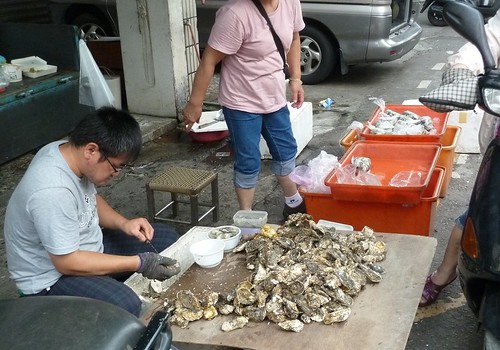It's been months since I updated this blog, and for a very good reason: I was too busy enjoying the delicious food in Taiwan. In my short stay there, I must have gained 2 clothing sizes, as I seemed to have done nothing but eat. Food there is incredibly delicious and fresh, and number of eateries is mind boggling. Furthermore, there are so many vegetarian options that it was almost ridiculously simple (with exceptions in certain areas). Instead of struggling to find a decent options, I was struggling to limit my intake given that I only have one stomach. For such a small island, Taiwan boosts a huge number of local produce and specialties, which I can't even begin to cover all.
My home town hosts a busy morning market (aka farmers market) that attracts farmers and vendors from all over every morning. The scene is lively, chaotic, messy, loud, dirty, noisy, crowded, and seemingly inexhaustible. Pedestrian, bicycles, scouter motorcycles crowd into a narrow lane, making moving around all but nearly impossible. The selections here are cheap, fresh, and abundant.
Morning market in Shalu
The fish vendors bring the buckets of live fish and you simply point to the ones you want.
Oyster vendors will shell out fresh oysters for you on the spot
Sausages are very popular
Vegetable vendors with their bicycle and trucks:
(I can only identify about half of the vegetables in these pictures)
Pineapples in Taiwan are amazingly sweet, and have a rich, bright yellow hue. The vendors peel and cut them for you. It takes about this guy 20 seconds to peel a pineapple.
From this market is where my grandmother and I go every morning to obtain daily produce and hunt down our breakfast. As you may have guessed, breakfast options are numerous, and many of them are unobtainable in the US, or for that matter, outside of Taiwan. Of all the foods I missed the most about Taiwan, it has to be the breakfast and the street foods, which -more than restaurant items- seemed to display uniquely local flairs.
Coming next: Breakfast Foods
I think every home baker has at some point searched for the perfect banana bread. We all have our preferences: some like it very dense and banana-y, others like it almost like a cake with chocolate chips. I like it moist, not to sweet, full of taste of bananas with some soft banana pieces hidden in the bread. Well, I think I found my perfect banana bread. The sourdough here balances out the sweetness of the bananas while giving it a moist, light texture. It's also a great way to use the extra sourdough starter.
The
original recipe was posted on the Fresh Loaf, but reviews and first attempt confirmed that it needed more bananas - the original recipe was a bit crumbly and in my opinion, need a more banana taste. I added one more banana, replaced the shortening with butter (will try with oil next time), and some other minor adjustments, and here was the version that I ended up with:
1/3 cup butter
1 cup of sugar (1/2 cup of honey or some combination thereof can be used - I used 3/4 cup sugar + 3 TB honey)
1 egg
2 cups all-purpose flour
1 tsp baking powder
1/2 tsp baking soda
1/2 tsp salt
1.5 cup mashed overripe banana (about 3 large; I like to roughly mash with some chunks of banana left)
1 cup sourdough starter
3/4 cup chopped walnuts or pecans
1 tsp vanilla or 1 tsp grated orange rind
Preheat oven to 350F.
Cream together the oil and sugar, add egg, and mix until blended. Stir in bananas and sourdough starter. Add orange rind or vanilla. Sift flour, measure again with salt, baking powder, and soda. Add flour mixture and walnuts or pecans to the first mixture, stirring just until blended. Pour into greased 9x5" loaf pan. Bake for 1 hour or until toothpick comes out clean. Cool before slicing.
As you can see based on the photos, I did not follow my own directions and wait for the bread to cool before slicing! I'm sure next time I'll make double batches and wait for one loaf to cool down before slicing so the slices would look better, but the bread smelled too good for me to wait around in front of it. Hence the crumbly - but delicious appearance. Also, I got to say I am a big fan of pecans - pecans all the way in banana bread.
I had some extra turnips lying around from that turnip soup and I wanted to cook it in the easiest way possible. Solution? Roasting!
This method can be used for pretty much any root vegetable and easily scaled up. I used tarragon here but other herbs such as rosemary or sage will work just as well.
Ingredients:
1 turnip
1 large carrot
1 potato
3 small cloves of garlic, unpeeled
1 TB tarragon
Olive oil
A pinch of salt
Honey mustard vinaigrette
Preheat oven to 450F.
Peel and cube the root vegetable, toss with the garlic cloves, herbs, and olive oil in baking dish. Lay the vegetables in a single layer and sprinkle lightly with salt. Place the baking dish on the middle rack. Bake for 20 minutes, check the vegetables for dryness. If dry, add a tablespoon or two of water to the baking dish and bake another 20 minutes or until tender. Remove from oven and immediately drizzle with honey mustard vinaigrette.

After a month-long hiatus due to an incredibly busy schedule, I'm finally back to updating this blog! With the arrival of spring - though it doesn't feel like so in Chicago - comes a bout of cold for me. And with cold seems to come the craving for soup and desserts.
So when I saw this
cake recipe on Smitten Kitchen (which is, by the way, a great website - as demonstrated by this cake) I knew immediately that I had to try it - I love crumbly, moist, not too sweet cakes, flavored by ripe fruits. I followed the original recipe pretty closely with a few exceptions: I left the apples unpeeled, reduce the sugar slightly as I always do, I used olive oil, and instead of walnuts I used pecans. Because I didn't have a bundt or tube pan, or a pan large enough to hold all the batter, I used a loaf pan and a pie pan to see how it would turn out. As you see, the two pans produce slightly different, but equally yummy, desserts.
The following is after my minor modification:
5 large apples
1 tablespoon cinnamon
5 tablespoons sugar
2 3/4 cups flour, sifted
1 tablespoon baking powder
1 teaspoon salt
1 cup vegetable oil ( I use olive oil)
1 3/4 cups sugar
1/4 cup orange juice
2 1/2 teaspoons vanilla
4 eggs
1 cup pecans, chopped (I coated the pecans in the cinnamon-sugar-apple juice)
 |
| prebake |
Directions:
Preheat oven to 350 degrees. Grease the pan(s). Core and chop apples into chunks. Toss with cinnamon and sugar and set aside.
Stir together flour, baking powder and salt in a large mixing bowl. In a separate bowl, whisk together oil, orange juice, sugar and vanilla. Mix wet ingredients into the dry ones, then add eggs, one at a time. Scrape down the bowl to ensure all ingredients are incorporated.
The apples and batter were divided between a 9'x5' metal loaf pan and a 12" glass pie pan. For the loaf pan, I followed the original instructions: half of the batter on the bottom, half of the apples, another half of the batter, and then topped with remaining apples and pecans. Because the pie pan was so shallow, I directly laid the apples on the bottom of the pan, pour the rest of the batter over the apples, and then top the batter with the remaining apples and pecans. The cakes were baked for 1 hour 15 minutes.
First, I tried the pie pan. It was delicious, and I liked the apples on the bottom of the pan. Then I tried the loaf pan. It was awesome! Super moist and so tender that the slices barely able to stand once they are cut. The metal bakeware produced a different crust than the glass, slightly thicker and crunchier. The cake is moistened by the oil and apple juice with no distinct note of olive oil. The apple skin gave pleasant contrast in texture without being hard or chewy, and pecans paired perfectly providing a nutty crunch.
 |
| right out of the oven |
 |
| a slice of loaf cake |
I put the remainder of the cake in the pie pan in the fridge, and next day, I had the cake again, both cold and warm (yes, I've very thorough when it comes to cake tasting!). The shallow cake actually tasted really good the next day cold, even better than previous day, with the slightly condensed cake almost tasting like crumble with apple-pecan strudel topping.
 |
| next morning |
Daikon and miso make a classier soup pairing. Since I only had turnips, I decided to try out this soup with turnips to see how it would turn out. As it turned out, turnips make a great stand-in and actually produces a mildly sweeter broth. The flesh is a little denser than daikon when fully cooked. This is a simple soup that can be done in 20 minutes and doesn't require broth preparation.
Ingredients
Oil
2 turnips or 1 daikon
6 cups water
1/4 cup miso, preferably white
Cilantro, several spring (*or turnip greens)
2 eggs, beaten*
Sugar, if needed
*For a vegan option, you can leave out the egg, but use a more assertive green like turnip greens and add the greens when the turnips are halfway cooked.
1. Wash the turnips. Remove the greens if they're attached. Peel and cut into 1/4" thick slices.
2. Heat up oil in the pan, then add the turnips and let them cook over medium heat without much stirring. When the pan begins to brown add a little bit of water at a time.
3. Once the turnips are nearly fully cooked through add the rest of the water and bring to a boil.
4. Upon boiling, turn the heat to low, and stir in the miso. Turn off the heat immediately, and swirl in the egg.
5. Taste for seasoning. Add 1/2 tsp of sugar if needed. Garnish with cilantro.
 |
| (I used scallion greens here) |
With the starter successfully made, now it's time for my first rye bread. I chose to make the Alpine baguettes from Local Breads as a first recipe because while the bread uses a rye starter, the bread itself is made using wheat flour, making the dough easier to handle.
First, soak the grain and seeds the night before making the bread. This recipes calls for oats, pumpkin seeds, sunflower seeds, flax seeds, and sesame seeds.
Next time, mix together the seeds and the flour mixture. This is when dough whisk comes in handy (thanks Joedy!).
As you can see, the dough is quite sticky.
Unfortunately I got distracted while measuring flour and forgot how much I added, so I tried to play by ear. I had to add A LOT of flour to prevent the dough from gluing onto my hands. My guess was that I miscounted by 1 cup. Even after adding +1 cup of flour, this is still a fairly sticky dough to work with. Finally, I realized that the trick is to use a pair of very well-oiled hands to knead the dough.
After the first rising, the dough divided into 3 pieces and each piece fold into thirds:
The dough is then rested for about an hour until it it puff up, and shaped into baguette form. It then goes into the oven for about 25 minutes. I didn't have parchment paper, so the baguette dough got somewhat misshaped when I lifted it from the counter to the baking stone.
Whole wheat grains taste better after it's been cooled down. However, I couldn't wait that long as I was hungry. When cut immediately after coming out of the oven, the inside look almost gummy:
It taste really good with lingonberry preserve:
As you can see, the appearance improved next day. It looks much more bread-like.
(Those are Italian veggie sausage in the background. I have to admit they are actually pretty good and the spiciness goes well with rye breads).
For a first attempt, I was happy with the way this bread turned out. It was the first time in years I had bread that somewhat resembled the bread I ate in Germany. The aroma of the bread is slightly tangy without being sour at all. The pumpkin seeds give it a nutty, earthen scent. The rye starter gave it a unique flavor that taste worlds apart from the rye one get at the supermarkets here. Despite forgetting how many cups of flours I put in and trying to eye it from there, the bread took a life of its own and was well-received by the people I shoved it to. So if people tell you that rye sourdough or German breads are hard to make, or if things don't look perfect, don't fret, just go make it. It may actually turn out fine!
Posted on 3:53 AM
|
·
edit
For some reason the Google Custom Search engine is not working. Until Blogger fixes this, you can use Google to search directly:
site:fromtarotopotato.blogspot.com KEYWORD
I apologize for the 2 week hiatus. I got involved in something that took my time away and consumed my attention - making a rye starter!
Let me first backtrack on how this started. Those of you who know me knows (and are probably tired of hearing about) how I fell in love with bread when I was in Germany. Before then, bread was fine, I liked eating sweet breads for snacks, but I thought it was a poor substitute for rice or pasta/noodle during meals. I used to know an Austrian hiker, who sniffed his nose up at American bread. I thought it was just a general European disdain for American mass-produced foods. As it turned out, he had a very good point when it comes to bread.
After I got into a baking frenzy last week, I decided to go check out the public library for bread books. I decided that I wanted to learn to bake multi-grain breads, which for me has a much more interesting texture than white breads. Skimming through the shelves, I saw a book that has been mentioned by several posters at The Fresh Loaf, Local Breads by Daniel Leader. I flipped through the pages, saw tons of Italian breads and French baguettes - white breads, and was about to put the book down, when I saw that the book had a section on German rye breads. I was sold.
Funnily, when I first started baking I was just going to learn basic sandwich bread, and at some point during decision making, I concluded that there was no reason spending time baking what I didn't enjoy eating, so decided to go for whole wheat despite the trickier dough handling. And with Leader's book triggering memory of those fond days at the German bakery, I decided to take the plunge and make rye sourdough. Not the steps most beginners would take, but I have accepted that I am a hopeless foodie.
The making of the starter was pretty easy: just some rye flour (which was actually quite some work to obtain), and water. That's it.
Day 1: mix 1/2 cup of rye flour + 1/4 cup of room temp (75F) water. At this point the thing look like clay.

Day 2: add 1/2 cup of rye flour + 1/4 cup room temp. water. The starter is stiff but has slightly more doughy feel to it.
From the side you can see the bubbles indicative of fermentation:
Day 3: Add 1/2 cup of rye flour + 1/4 cup warm (90F) water. This is where I messed up - I added room temperature water as I didn't read the instructions carefully - but I didn't realize this until 2 days later. You can see that the starter becoming more doughy, and there are now bubbles as sign of fermentation. Starter is beginning to start to smell like - per Dan Leader - "rotten fall leaves and fermented apples."
Day 4: To test whether the starter is ready, I added 1/2 cup of rye flour + 1/2 cup of warm water and see if it doubles in size in 12 hours. It did not. *Belatedly realize my mistake on day 3*
Day 5: Starter still not doubled. I am thinking I've killed the starter. My roommate Jamie suggests that I move the starter to a warmer area since our apartment seems to be underheated. I moved it near the radiator.
Day 6. Success!! Starter have doubled with lots of bubbles when viewed from the side. It smells just right too. I scooped out ~1/4 cup of the starter, fed it 1/2 cup of rye flour + 1/2 cup of warm water, and set it near the radiator, in preparation for my very first rye bread making.
The just-refreshed starter has a more liquid appearance liquid and almost resembles batter:
While most instructions will say to discard the rest of the starter, I felt that was a waste (rye flour is expensive!), so I gave out starter to friends who wanted it. The rest, I refreshed it again, and store it in the fridge for future use. Which means that there will soon be more posts featuring sourdough starter!
Next, my very first rye bread,
alpine baguettes.
I've recently got interested in bread baking. I saw the Bread Bible: 300 favorite recipes by Beth Hensperger, and decided to take a stab at the recipes. What I liked when I browsed the book was that the recipe seemed good, well thoughout, and no nonense recipes that didn't require every newest gadget at William Sonoma. Every recipe had hand mix instructions, and these are the recipes I could see people eating 20 years from now.
The recipe that caught my eye was the Italian whole wheat raisin walnut bread. Ever since my stay in Germany, I found that I have become drawn to the nuttiness of whole wheat and multi-grain breads. When made properly, they have a delightful chewiness and sweet, concentrated flavor that sets it apart from white breads. And when properly made, they are not heavy.
The process for this bread was straight forward. Luckily for me, someone at Food.com have uploaded the entire recipe and saved me the effort from retyping. The recipe calls for poofing the yeast, kneading and giving the dough two rises. Because I decided to start this recipe at 11pm at night, I decided to not wait until 5 am to finish the kneading in one setting. Instead, after the first raise I put the dough in the back porch, which I rated at about 20F at night, and will continue the second stage when I return from work the next day. The second day after I kneaded the dough I decided once again to sleep first and wait until third day to bake the bread. I crossed my fingers and hoped the bread turned out ok and not into a pungent fermented sourdough.
I finally got around to baking the third day. Mostly because it was the infamous blizzard and I didn't have anywhere else to go. Given that I had let the dough sit for two days without adjusting the yeast called for in the original recipe, I was expecting something that tasted like breaded sourkraut. Here is the picture of the bread, sliced:

I was pleasantly surprised when I saw how beautifully the bread looked when it came out. The bread had a beautiful, even crust. The interior was moist and dense. It was obvious that the bread was slightly overly fermented as the bread had a sour tang and the air pockets reminds me of the yogurt bread. However, it was still one of the bread I ever tasted. The balance between the sweet raisins and crunchy walnut set in whole wheat bread was just perfect. I circumvented the sour problem by topping the bread with honey. The only other issue that I noted, besides the slight over-fermentation, was that I had to add a lot of flour (+ 1/2-1 cup) during kneading to prevent the dough from sticking too much. This threw off the sugar and salt balance slightly, and the bread did feel like it needed a bit more salt and sugar. Next time I may add a little less water to start with, and tried to follow the time instructed!
Cold soba noodles is one of the greatest snacks (yes, I am going to call this a snack). Simply boil in, add some dipping sauce, and sprinkle with some toasted sesame seeds, and you're done! Ten minute lunch.
Most Asian supermarkets will sell the dipping sauce. However, they will all contain fish as the base. To make your own,
Just hungry has an excellent post on how to make your own sauce. The vegetarian dashi can be made by soaking kombu and shiitake mushroom.
If you like me, however, you will find that the vegetarian versions, while good, don't always have the savory depth of the fish version. Not to mention I like things spicy. So...I decided to play around with the taste a little more. I combine the stock with some vegetarian oyster sauce made from shiitake mushrooms, and add red chili oil (with crushed red chilis) and sesame oil. I am afraid that my version is not very Japanese, but it sure is tasty to me.
What are some of your favorite ways to eat soba?
I made these for Jamie's birthday party. These Guinness chocolate cupcakes with creamcheese icing were delicious. I accidently put too much Guinness but that apparently just contributed to its yumminess. You can find the recipe
here on the Food Network site.
Notes on the recipe: The icing directions given on the site has A LOT of sugar. I used about 20% less sugar than the printed directions, and still found the icing way too sweet. Next time I will use even less sugar.
This is a soup made with chana dal I made for my Hyde Park dinner party. The cooking is pretty similar to the standard way to cook dal. First I boiled the chana dal with crushed ginger and tumeric, and add chopped tomatoes and salt when the legumes are almost done cooking. For the toppings, I brown the onions, and then add cumin seeds, dried red chili peppers, sliced garlic, and cumin powder. Right when dal get cooked through I add the toppings to the dal and mixed everything together and garnish with cilantro.
The soup was a hit.
Posted on 2:28 AM
|
·
edit
Hello
Those of you who know me already realized that food is my passion. I have been obsessively taking pictures of food I cook and eat and I finally decided to document it in a way that is accessible for both me and others I want to share it with.
This is my first time taking a stab at this. Please feel free to give me feedback on how I can improve this site.
Thanks!
Amy






































